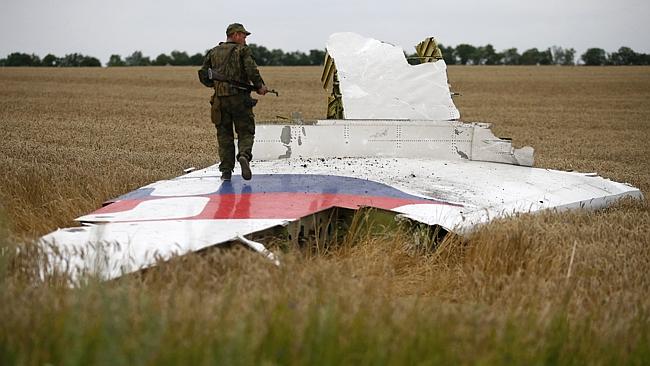
© The AustralianAn armed pro-Russian separatist stands on part of the wreckage of MH17
Air routes in the eastern Ukraine were shut down yesterday after the shock destruction of Malaysia Airlines Flight MH17 from a missile attack, but questions remain about whether authorities should have closed the route sooner.
Europe's Eurocontrol said Ukrainian authorities had informed it that routes through Dnipropetrovsk Flight Information Region (FIR) were closed until further notice and flight plans filed for the routes were now being rejected.
The influential Flight Safety Foundation has already called for an immediate independent international investigation into the incident and there are calls for a new body to better estimate the risk posed by global trouble spots.
University of Central Queensland aviation specialist Ron Bishop, who spent 23 years with US Air Force special operations, said a better notification system for global hotspots was needed.
"We would never fly over North Korea so we need to probably work that out ... is it worth the risk,'' he said.
"This is very similar to World War I and World War II when the submarines used to take out the passenger liners, and as we go forward I think we're going to see more things like this.''By the time authorities acted to close the airspace, the MH17 crash had already prompted carriers such as Singapore Airlines and Thai Airways International to announce they would take alternate routes and Delta Air Lines said it had stopped flying through Ukrainian airspace because of "an abundance of caution''.
But some airlines, such as British Airways and Air France, had been avoiding the airspace for some time.
BA, citing safety, said it was not using Ukrainian airspace with the exception of a daily London-Kiev service, where the destination was several hundred kilometres from the crash site.
The Dnipropetrovsk routes had been shut below 32,000ft because of the fighting but at 33,000ft, the full Malaysian Boeing 777 had been considered above the danger zone. It was also outside restricted airspace around the Crimean city of Simferopol, where potential conflicts between the Ukraine and Russia over who controlled the airspace had created a safety issue.
It was this conflict that prompted the US Federal Aviation Administration to issue on April 3 a widely quoted Notice to Airmen, or NOTAM, prohibiting US flight operations over the Crimea and areas adjacent to the Black Sea and Sea of Azov.
But the NOTAMs did not cover the airspace where MH17 crashed and none of the warnings referred to potential missile attacks. Instead, it was the competing claims about who "owned' the airspace that was seen as the safety issue.
Airlines prefer to fly a great circle route, which is generally the shortest distance between the departure point and a destination.
The corridor through Ukraine is a popular one for airlines flying between Europe and Asia, used by about 300 flights a day.
Flight plans are influenced by the need to remain in controlled airspace throughout the journey and also to avoid prohibited, restricted or danger areas.
Airlines also consider whether a plan is the shortest route possible while avoiding safety issues, the level of service provided by air traffic control and the fees they charge.
"That is not a factor that would influence an airline to fly one route or another if there is a safety issue,'' an international expert in air traffic control said. "But it would affect their decision to fly one route or another if all of safety issues are negated and it then became a question of what an ATM will charge for services versus how much fuel they are going to burn."
Some airlines would also have been worried about the risk of "short notice closure'' .
"One of the reasons that airlines will decide to fly around that airspace is not because they thought they're going to get shot down, it's because they don't want to rearrange their flight plans at short notice if the airspace suddenly closes,'' the expert said.
MH17 was one of four aircraft, including a Singapore Airlines Boeing 777 and an Air India Boeing 787, in the area when it was shot down. Qantas, which has used the route in the past, was not involved because it has been flying about 400 nautical miles to the south of the Ukraine since moving its European hub to Dubai.
Reader Comments
to our Newsletter